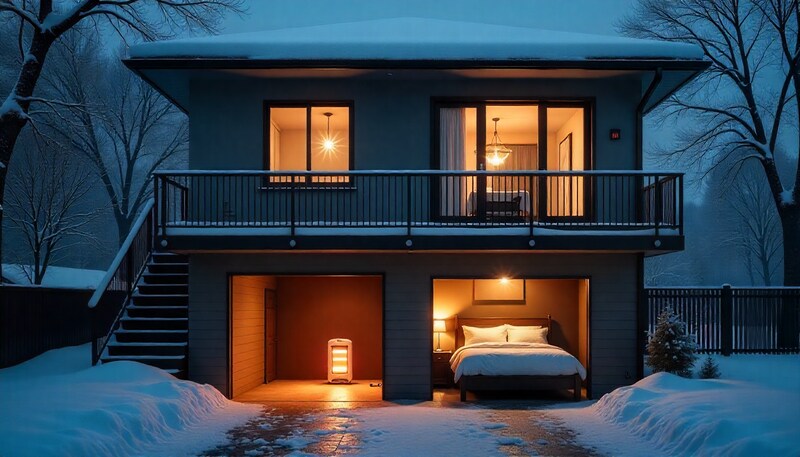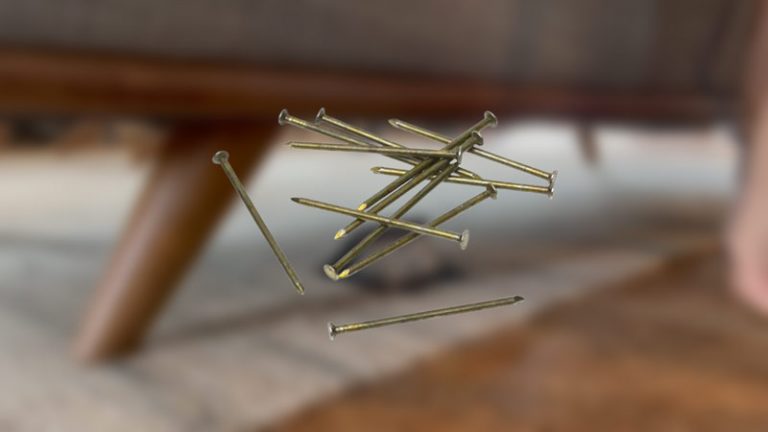Master Bedroom Over Garage Freezing? Your #1 Guide to Permanent Comfort
You envisioned a private sanctuary, a spacious retreat away from the main hustle of the house. But the reality of your master bedroom over the garage is anything but serene.
Instead, you’re battling freezing floors in the winter and sweltering heat in the summer. Every time the garage door rumbles open, it feels like it’s right in your room. This dream space has become the most uncomfortable room in your home.
This isn’t just an inconvenience; it’s a sign of underlying problems that can affect your comfort, energy bills, and even your home’s health. This guide will walk you through why this problem happens and provide a clear, step-by-step plan to reclaim your master suite for good.
You'll Learn About
Why Your Bedroom Over the Garage is an Uncomfortable Island
Rooms built over garages, often called “bonus rooms,” are notorious for temperature swings and noise issues. These problems stem from the fact that the garage is typically unconditioned space, creating a massive weak point in your home’s thermal and acoustic envelope.
Let’s break down the core issues that turn your master bedroom into a place you want to escape, not retreat to.
The Great Unseen Problem: Lack of Insulation
The number one culprit behind your discomfort is almost always inadequate or improperly installed insulation. The floor of your bedroom is the ceiling of your garage, a space that is exposed to extreme outdoor temperatures. Without a proper thermal barrier, that cold or heat transfers directly into your living space.
Builders often cut corners here, using standard fiberglass batts that can leave gaps or fail to create a complete air seal. This allows frigid winter air to chill your floors and summer heat to radiate upwards, making your HVAC system work overtime to keep up.
Air Leaks: The Hidden Comfort Killers
Insulation alone isn’t enough if your room isn’t properly air-sealed. Gaps and cracks around the garage door, windows, and where the foundation meets the walls allow unconditioned air to infiltrate the garage.
This creates drafts that flow up through penetrations in the bedroom floor for wiring, plumbing, and ductwork. The result is a room that constantly feels drafty and struggles to maintain a consistent temperature.
The Noise Nightmare: From Car Engines to Tool Benches
Sound travels easily through the structure of your home, and the space above a garage is ground zero for noise pollution. The rumble of the garage door opener, the vibration of a car engine, and the sounds from a workshop can all travel directly into your bedroom.
Standard construction does little to block this combination of airborne and impact noise, turning your peaceful retreat into a source of constant disruption. Some homeowners also have concerns about potential fumes from the garage entering the living space above if it is not properly sealed.
HVAC System Shortcomings
Often, the master bedroom over the garage is at the furthest point from the home’s furnace and air conditioner. This long duct run means the airflow reaching the room is often weak and insufficient to combat the extreme temperature loss.
Furthermore, the home’s single thermostat, usually located in a central hallway, can’t accurately read the temperature in this isolated room. The system shuts off thinking the whole house is comfortable, leaving your master suite to suffer.
The Ultimate Solution: A Step-by-Step Comfort Masterplan
Fixing a master bedroom over the garage requires a multi-faceted approach. You must treat the floor, walls, and HVAC system as interconnected parts of a whole. Follow these steps to transform your uncomfortable room into a year-round oasis.
Step 1: Supercharge Your Insulation Strategy
Your absolute first line of defense is upgrading the insulation in the garage ceiling. This is the most critical step to stop heat transfer. Simply adding more of the wrong insulation won’t work; you need a material that both insulates and air seals.
Spray foam insulation is widely considered the premier solution for this application. It expands to fill every crack and crevice, creating a seamless air and thermal barrier. This not only stops drafts but also adds structural rigidity and acts as a sound dampener.
Another effective method is the “drill-and-fill” technique using dense-pack cellulose. Professionals drill small holes in the garage ceiling, blow insulation into the cavities until they are tightly packed, and then patch the holes. This avoids the need to tear down the entire ceiling.
| Insulation Type | Key Advantage | Considerations | Best For |
|---|---|---|---|
| Open-Cell Spray Foam | Excellent air seal, great sound dampening, expands significantly. | Lower R-value per inch than closed-cell; permeable to moisture. | Soundproofing and filling large, irregular cavities. |
| Closed-Cell Spray Foam | Highest R-value per inch, acts as a vapor barrier, adds structural strength. | More expensive, less sound dampening than open-cell. | Maximum thermal performance and moisture control. |
| Dense-Pack Cellulose | Good thermal and sound insulation, made from recycled materials. | Requires professional installation; can settle if not packed properly. | Retrofitting finished ceilings without major demolition. |
| Fiberglass Batts | Inexpensive and widely available for DIY. | Does not stop air leakage; prone to gaps and moisture retention. | Budget projects where air sealing is addressed separately. |
Don’t stop at the ceiling. Ensure the exterior walls of the bedroom are also well-insulated, and consider adding an insulated garage door to reduce the overall temperature fluctuation in the space below.
Step 2: Seal Every Crack and Gap
Before you insulate, you must air seal. Use caulk or canned spray foam to seal all penetrations between the garage and the bedroom floor. Pay close attention to holes drilled for electrical wires, plumbing pipes, and HVAC ducts.
Weatherstrip the door leading from the garage into the house and ensure the main garage door has a robust seal at the bottom and along the sides. These small steps make a huge difference in preventing drafts and energy loss.
Step 3: Soundproof for Serenity
To tackle noise, you need to add mass and decouple the bedroom floor from the garage ceiling structure. If you have the ceiling open for insulation, this is the perfect time to add soundproofing measures.
One effective technique is using resilient channels. These metal strips attach to the joists and the drywall attaches to them, creating a small gap that breaks the path of sound vibrations. Combining this with special sound-dampening drywall or a layer of mass-loaded vinyl can dramatically reduce noise.
If you’re not removing the drywall, focus on the source. Vibration isolators can be installed on the garage door opener motor to reduce the transfer of noise to the framing. Upgrading to a belt-drive opener can also make a significant difference.
Step 4: Optimize Your HVAC for Perfect Temperatures
Even with perfect insulation, an underpowered HVAC system will struggle. The best solution for a room over the garage is often to give it its own dedicated heating and cooling system.
A ductless mini-split system is the ideal choice. These units consist of an outdoor compressor and an indoor air handler mounted on the wall. They are incredibly energy-efficient and allow you to control the temperature of that one room independently from the rest of the house.
If a mini-split isn’t in the budget, talk to an HVAC professional about other options. These might include adding a duct booster fan to increase airflow to the room or installing a smart thermostat with remote sensors to provide more accurate temperature readings.

Beyond the Basics: Advanced Comfort and Safety Tips
Once you’ve tackled the big four—insulation, air sealing, soundproofing, and HVAC—a few finishing touches can elevate the comfort and safety of your master suite.
Don’t Forget the Floor Coverings
The type of flooring you choose can have a noticeable impact. Wall-to-wall carpeting with a high-quality, thick pad adds an extra layer of thermal insulation and helps absorb sound.
If you have hard surfaces like wood or laminate, using large, thick area rugs can help take the chill off the floor in the winter and reduce echo in the room.
Carbon Monoxide: The Silent Threat
This is non-negotiable. Any bedroom located above a garage must have a working carbon monoxide (CO) detector. Fumes from a running vehicle can seep through cracks and become a deadly hazard.
Ensure your detector is installed according to manufacturer instructions and test it regularly. This simple device is a critical life-saving measure.
Checking Your Electrical System
Properly planned additions account for electrical loads, but sometimes shortcuts are taken. If you notice flickering lights or outlets that seem loose, it could be a sign of a deeper issue. It’s important to understand why this happens, as sometimes you might see signs like outlet covers that are bending, which can indicate heat buildup or wiring problems behind the wall.
Similarly, be aware of other hidden risks in your home. Unconventional installations, like an electric water heater in a bedroom closet, carry their own specific safety considerations that homeowners should understand.
Is Building a Master Bedroom Over the Garage Worth It?
Absolutely. Adding a master suite over the garage is one of the most cost-effective ways to add significant square footage and value to your home without expanding its footprint. You gain a private, spacious room that can be a true luxury retreat.
The key is to address the unique challenges from the start. By investing in proper insulation, air sealing, and a dedicated HVAC solution, you can overcome the common pitfalls and create a space that is just as comfortable and quiet as any other room in your house. Thinking about overall home comfort can also lead you to improve other areas, such as learning how to block heat from a sliding glass door to maintain a consistent temperature throughout.
By following this guide, you can confidently turn that cold, noisy bonus room into the comfortable and serene master bedroom you’ve always wanted.

